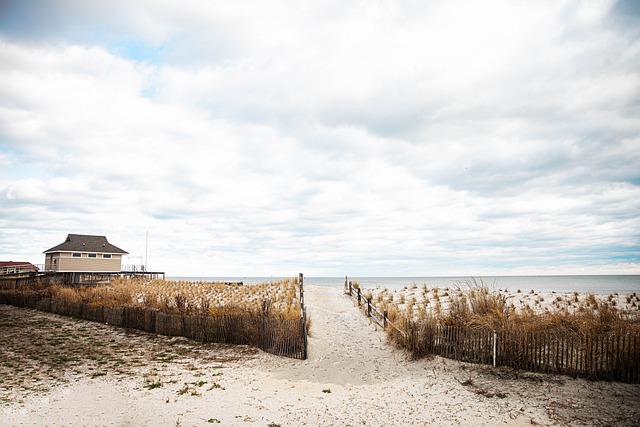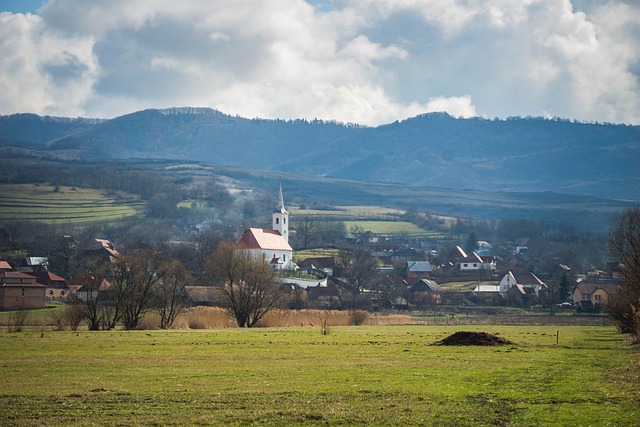The Twin Lights Lighthouse in Monmouth County, New Jersey, is an emblematic historical site that has played a crucial role in guiding maritime traffic along the Atlantic coast. It stands as a testament to the region's rich geographical and ecological diversity, its historical significance, and its commitment to preserving maritime heritage. Today, it serves not only as a museum but also as an educational center that provides interactive experiences and workshops for diverse audiences, all aimed at enhancing understanding of its historical importance, technological advancements like the Fresnel lens, and the broader ecological context of coastal lighthouses. Monmouth County's efforts to preserve this landmark include stabilization, repair, and integration of modern technology to ensure it remains a vibrant educational resource and a must-visit tourist destination. The Twin Lights Lighthouse is a symbol of resilience and innovation that connects Monmouth County's past with the present, offering a unique window into American maritime history.
Embark on a luminous journey through the rich tapestry of history with the Twin Lights Lighthouse, an enduring beacon nestled in Monmouth County, New Jersey. This article illuminates its origins and significance, delves into its architectural splendor, and examines its pivotal role in maritime safety. Situated amidst a breathtaking landscape, the lighthouse stands as a testament to American ingenuity and resilience. Discover how you can engage with this national treasure today through visits and educational programs, and learn about the dedicated efforts to preserve it for posterity. Join us as we shine a light on this historic landmark’s lasting legacy.
- The Historic Beacon: Exploring the Origins and Significance of Twin Lights Lighthouse
- Architectural Marvel: A Closer Look at Twin Lights Lighthouse's Design and Construction
- Navigational Pioneer: How Twin Lights Lighthouse Revolutionized Maritime Safety in Monmouth County NJ
- The Spectacular Setting: The Environmental and Geographical Features Surrounding the Lighthouse
- A National Treasure: Twin Lights Lighthouse's Place in American History and Preservation Efforts
- Interactive Experience: Engaging with Twin Lights Lighthouse Today Through Visits and Educational Programs
- Preserving Legacy: Ongoing Efforts to Maintain and Restore Twin Lights Lighthouse for Future Generations
The Historic Beacon: Exploring the Origins and Significance of Twin Lights Lighthouse

Located in Highlands, New Jersey, within the heart of Monmouth County, the Twin Lights Lighthouse stands as a testament to maritime navigation’s evolution and the ingenuity of its era. Constructed in the late 19th century, this historic beacon was one of the first lighthouses in the United States to employ a system of range lights to guide vessels safely into New York Harbor. Its twin towers, each with a distinctive light, were a novel approach to aiding navigation and preventing shipwrecks along the treacherous Sandy Hook shoreline. The lighthouse’s origins are deeply rooted in the need for improved maritime safety measures, reflecting the technological advancements of its time and the critical role that lighthouses play in coastal communities. The Twin Lights, with their unique Fresnel lenses, were among the most powerful lighting systems of their day, providing a vital service to seafarers and the shipping industry. Today, the lighthouse continues to be a significant landmark in Monmouth County NJ, offering visitors a glimpse into the past while standing as a sentinel overlooking the New York skyline and the vast expanse of the Atlantic Ocean. Its legacy endures, not only as a navigation aid but also as a symbol of American innovation and dedication to safeguarding human life at sea.
Architectural Marvel: A Closer Look at Twin Lights Lighthouse's Design and Construction

The Twin Lights Lighthouse, a historic beacon located in Monmouth County, New Jersey, stands as a testament to the ingenuity and craftsmanship of 19th-century lighthouse design. Its architectural marvel is evident from its distinctive twin towers, which are not only aesthetically striking but also serve a practical purpose in navigation. Constructed under the guidance of the U.S. Army Corps of Engineers, the lighthouse was completed in 1862 and has since been a critical aid to maritime safety along the New York and New Jersey coasts. The design incorporates innovative Fresnel lenses, which, with their prismatic properties, amplified the light’s intensity and visibility at great distances. The structural elements of the lighthouse, including its red brick exterior and cast-iron towers, have withstood the test of time, reflecting the durability and careful planning that went into its construction. The Twin Lights, particularly the First Light, which was one of the first to use an electric light source, played a pivotal role in maritime navigation, marking the entrance to New York Harbor and providing a vital navigational tool for ships passing through the Sandy Hook Proving Ground. Today, visitors can explore the lighthouse and its surrounding area, which is rich with history and offers panoramic views of the Atlantic Ocean, making it a must-see destination in Monmouth County for both history enthusiasts and casual tourists alike.
Navigational Pioneer: How Twin Lights Lighthouse Revolutionized Maritime Safety in Monmouth County NJ

The Twin Lights Lighthouse, standing tall on the grounds of the historic Sandy Hook Summit in Monmouth County, New Jersey, has long been a beacon of innovation and safety for maritime navigation. Constructed in the mid-19th century, this architectural marvel was more than just a guide for sailors; it was a pioneer in the realm of maritime safety technology. Its two lights—a white light visible up to nineteen miles and a fixed red light—provided a unique system that helped vessels navigate the treacherous sandbars and narrow shipping channels off the New Jersey coast. This dual lighting system was a significant improvement over previous lighthouse designs, allowing for more precise directional guidance. The Twin Lights not only enhanced the safety of maritime travel but also marked a pivotal moment in the evolution of lighthouse technology, influencing the design and function of lighthouses worldwide. Its revolutionary Fresnel lens, one of the first of its kind, magnified the light emitted, ensuring that the beacon was visible to ships far out at sea, thereby reducing the risk of shipwrecks and enhancing the overall safety of maritime commerce in Monmouth County, NJ. The Twin Lights Lighthouse remains a testament to the ingenuity and commitment to safety that has long characterized Monmouth County’s contribution to the field of maritime navigation.
The Spectacular Setting: The Environmental and Geographical Features Surrounding the Lighthouse

Situated in the heart of Monmouth County, New Jersey, the Twin Lights Lighthouse stands as a beacon of history and navigation amidst a landscape rich with environmental and geographical diversity. This iconic lighthouse, perched atop the cliffs of Navesink, offers a breathtaking view of the surrounding Atlantic coastline, where the rugged terrain meets the expansive ocean. The lighthouse, with its distinctive twin towers, not only marks the entrance to New York Bay but also serves as a backdrop to the area’s natural beauty, including the rolling hills and verdant woodlands characteristic of the region. The geography of Monmouth County is a tapestry of diverse ecosystems, from the sandy beaches and dunes to the freshwater wetlands and marshes that are home to a variety of wildlife, contributing to the unique biodiversity of the area. The Twin Lights Lighthouse, a National Historic Landmark, stands as a testament to human ingenuity and its harmonious relationship with the natural environment that surrounds it in Monmouth County, NJ.
A National Treasure: Twin Lights Lighthouse's Place in American History and Preservation Efforts

The Twin Lights Lighthouse, an iconic beacon located in Monmouth County, New Jersey, holds a significant place in American history and maritime navigation. Erected in the late 19th century, this historic lighthouse has stood as a testament to the ingenuity and foresight of its builders, guiding ships safely along the treacherous Sandy Hook shoreline. Its distinctive design, featuring two cast-iron towers with lenses that rotated to flash light beams in a distinctive pattern, was not only an engineering marvel but also a vital tool for seafarers navigating the Atlantic coast. Over the years, the Twin Lights has witnessed countless maritime journeys, ensuring safe passage and contributing to the rich tapestry of American maritime heritage.
Today, the Twin Lights Lighthouse continues to be a cherished landmark within Monmouth County, NJ. Preservation efforts have been instrumental in maintaining its structural integrity and historical significance. These efforts are not only about safeguarding a piece of infrastructure but also about preserving a chapter of American history. The lighthouse has undergone restoration projects that have brought it back to its former glory, while also integrating modern technology to keep it relevant as an educational tool and tourist attraction. The Twin Lights Lighthouse Museum, located on the site, offers visitors a glimpse into the past, showcasing the evolution of lighthouse technology and its critical role in American history. Through these preservation initiatives, the Twin Lights stands as a beacon not only of light but also of continuity, linking past, present, and future generations with the maritime legacy of Monmouth County, NJ.
Interactive Experience: Engaging with Twin Lights Lighthouse Today Through Visits and Educational Programs

Situated in the picturesque Navesink River within Monmouth County, New Jersey, Twin Lights Lighthouse stands as a beacon of history and education. Visitors can now immerse themselves in its storied past through a series of interactive experiences that bring the lighthouse to life. The site offers guided tours that delve into the lighthouse’s role as an aid to navigation, its involvement in the Fresnel lens innovation, and its significance during both the Civil War and the Revolutionary War. Interactive exhibits allow guests to engage with historical artifacts and multimedia presentations, providing a hands-on understanding of the lighthouse’s impact on maritime history.
Educational programs at Twin Lights Lighthouse are meticulously designed to cater to both adults and children, offering a range of learning opportunities from its history to its scientific contributions. These programs often include workshops, lectures, and events that highlight the lighthouse’s importance within Monmouth County’s cultural heritage. The lighthouse also serves as an outdoor classroom where visitors can learn about ecological conservation, local flora and fauna, and the environmental impact of coastal lighthouses. Through these engaging and informative experiences, Twin Lights Lighthouse not only preserves its historical significance but also educates and inspires future generations in Monmouth County, NJ.
Preserving Legacy: Ongoing Efforts to Maintain and Restore Twin Lights Lighthouse for Future Generations

Situated on the shores of the Hudson River in Monmouth County, New Jersey, the Twin Lights Lighthouse stands as a beacon of history and navigation. Its twin towers, once guiding mariners safely to shore, now serve as a testament to innovation and engineering from the 19th century. Preserving this iconic landmark is a collaborative effort among local historians, conservationists, and community members who recognize its historical significance and its role in the maritime heritage of New Jersey. The ongoing maintenance and restoration projects are crucial for safeguarding the lighthouse’s structural integrity and ensuring that it remains a vibrant educational tool and tourist attraction. These efforts involve meticulous preservation techniques to maintain the original design and materials, as well as modern technology to enhance visitor experiences and interpretive exhibits. The dedication to maintaining Twin Lights Lighthouse not only honors its past but also secures its legacy for future generations to explore and appreciate.
The commitment to preserving the Twin Lights Lighthouse is evident in the various initiatives undertaken by Monmouth County. These include stabilization of the structures, repair of any weather-related damage, and the implementation of energy-efficient systems to reduce environmental impact. The local government’s support, alongside grants and donations from preservation societies, allows for continuous improvements and historical research that contribute to a deeper understanding of its significance in maritime history. Through these concerted efforts, the Twin Lights Lighthouse continues to be a shining example of Monmouth County’s rich cultural and historical tapestry, offering a glimpse into the past while standing as a stalwart symbol against the Atlantic Ocean’s relentless sea breeze.
